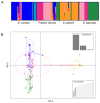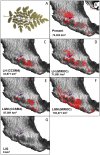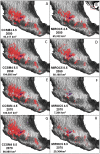Molecular evidence and ecological niche modeling reveal an extensive hybrid zone among three Bursera species (section Bullockia)
- PMID: 34797901
- PMCID: PMC8604287
- DOI: 10.1371/journal.pone.0260382
Molecular evidence and ecological niche modeling reveal an extensive hybrid zone among three Bursera species (section Bullockia)
Abstract
The genus Bursera, includes ~100 shrub and trees species in tropical dry forests with its center of diversification and endemism in Mexico. Morphologically intermediate individuals have commonly been observed in Mexican Bursera in areas where closely related species coexist. These individuals are assumed to result from interspecific hybridization, but no molecular evidence has supported their hybrid origins. This study aimed to investigate the existence of interspecific hybridization among three Mexican Bursera species (Bullockia section: B. cuneata, B. palmeri and B. bipinnata) from nine populations based on DNA sequences (three nuclear and four chloroplast regions) and ecological niche modeling for three past and two future scenario projections. Results from the only two polymorphic nuclear regions (PEPC, ETS) supported the hybrid origin of morphologically intermediate individuals and revealed that B. cuneata and B. bipinnata are the parental species that are genetically closer to the putative hybrids. Ecological niche modeling accurately predicted the occurrence of putative hybrid populations and showed a potential hybrid zone extending in a larger area (74,000 km2) than previously thought. Paleo-reconstructions showed a potential hybrid zone existing from the Last Glacial Maximum (~ 21 kya) that has increased since the late Holocene to the present. Future ecological niche projections show an increment of suitability of the potential hybrid zone for 2050 and 2070 relative to the present. Hybrid zone changes responded mostly to an increase in elevational ranges. Our study provides the first insight of an extensive hybrid zone among three Mexican Bursera species based on molecular data and ecological niche modeling.
Conflict of interest statement
The authors have declared that no competing interests exist.
Figures





References
-
- Grant V. Plant Speciation. Columbia University Press; 1981. doi: 10.7312/gran92318 - DOI
-
- Harrison RG. Hybrid Zones and the Evolutionary Process. Harrison R.G., editor. Oxford University Press, Inc; 1993. https://books.google.com.mx/books?hl=en&lr=&id=aFJFkVKskYIC&oi=fnd&pg=PA...
-
- Ortego J, Gugger PF, Riordan EC, Sork VL. Influence of climatic niche suitability and geographical overlap on hybridization patterns among southern Californian oaks. J Biogeogr. 2014;41: 1895–1908. doi: 10.1111/jbi.12334 - DOI
Publication types
MeSH terms
LinkOut - more resources
Full Text Sources
Miscellaneous

